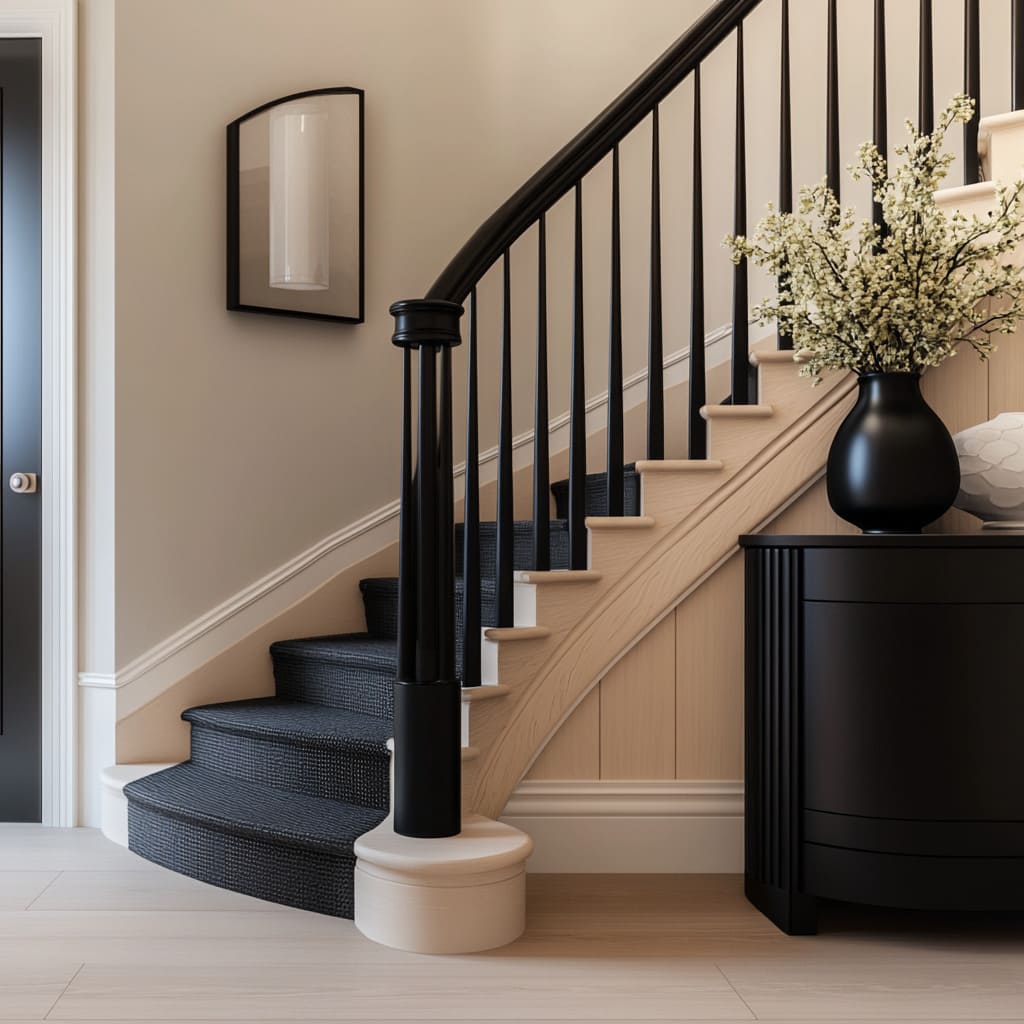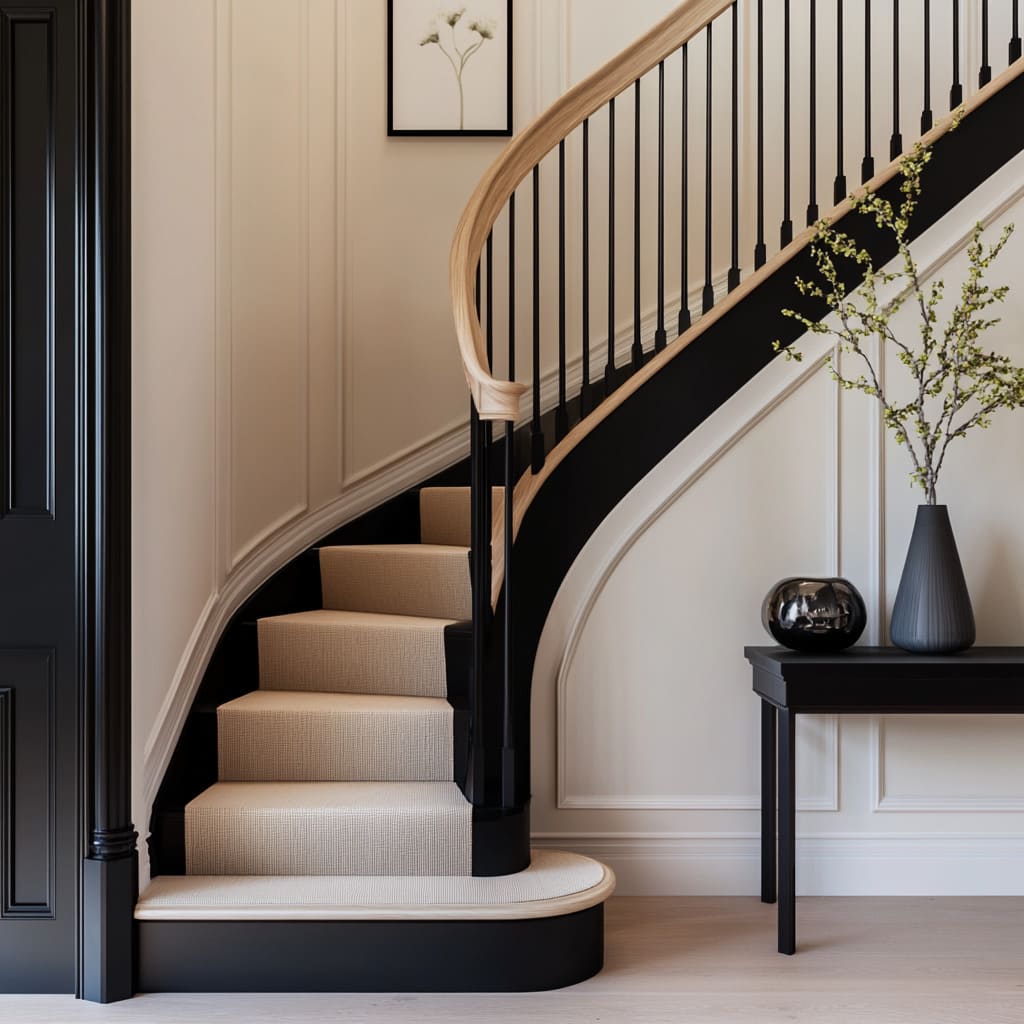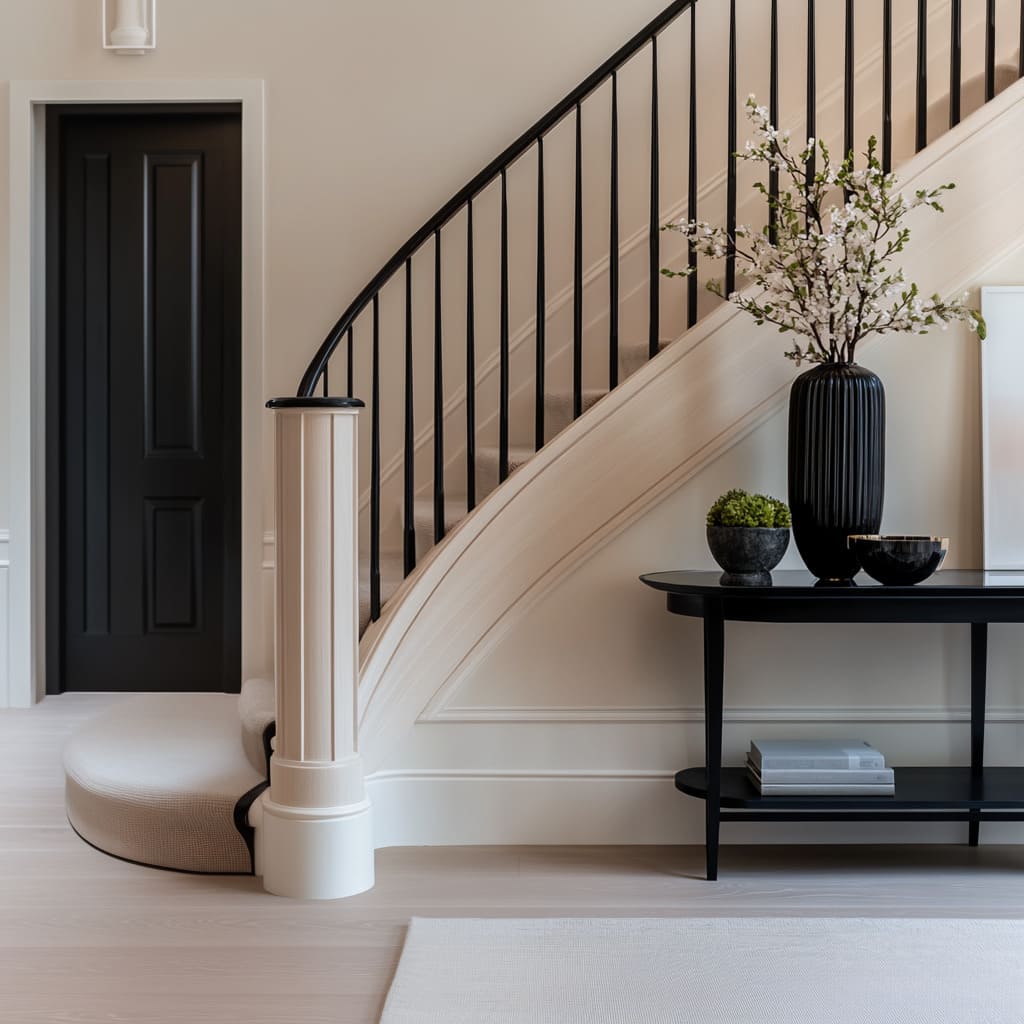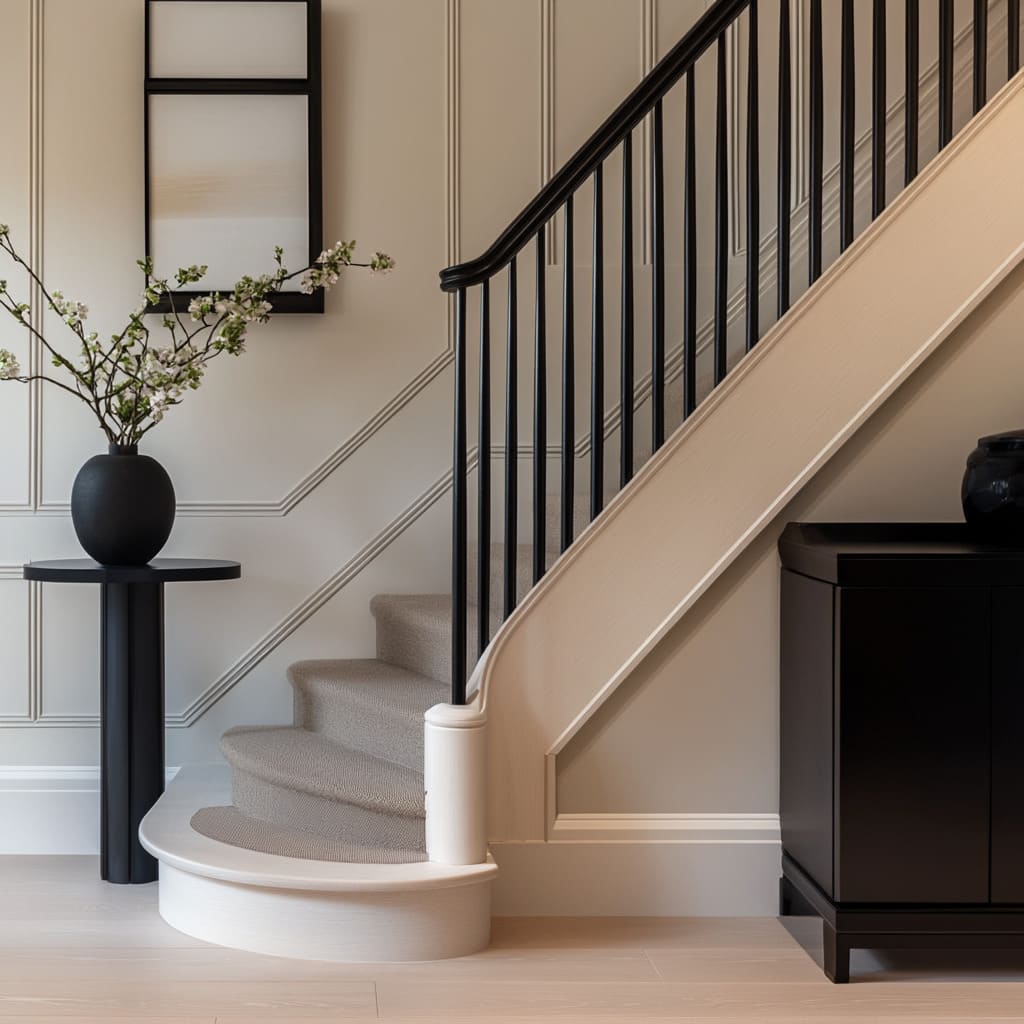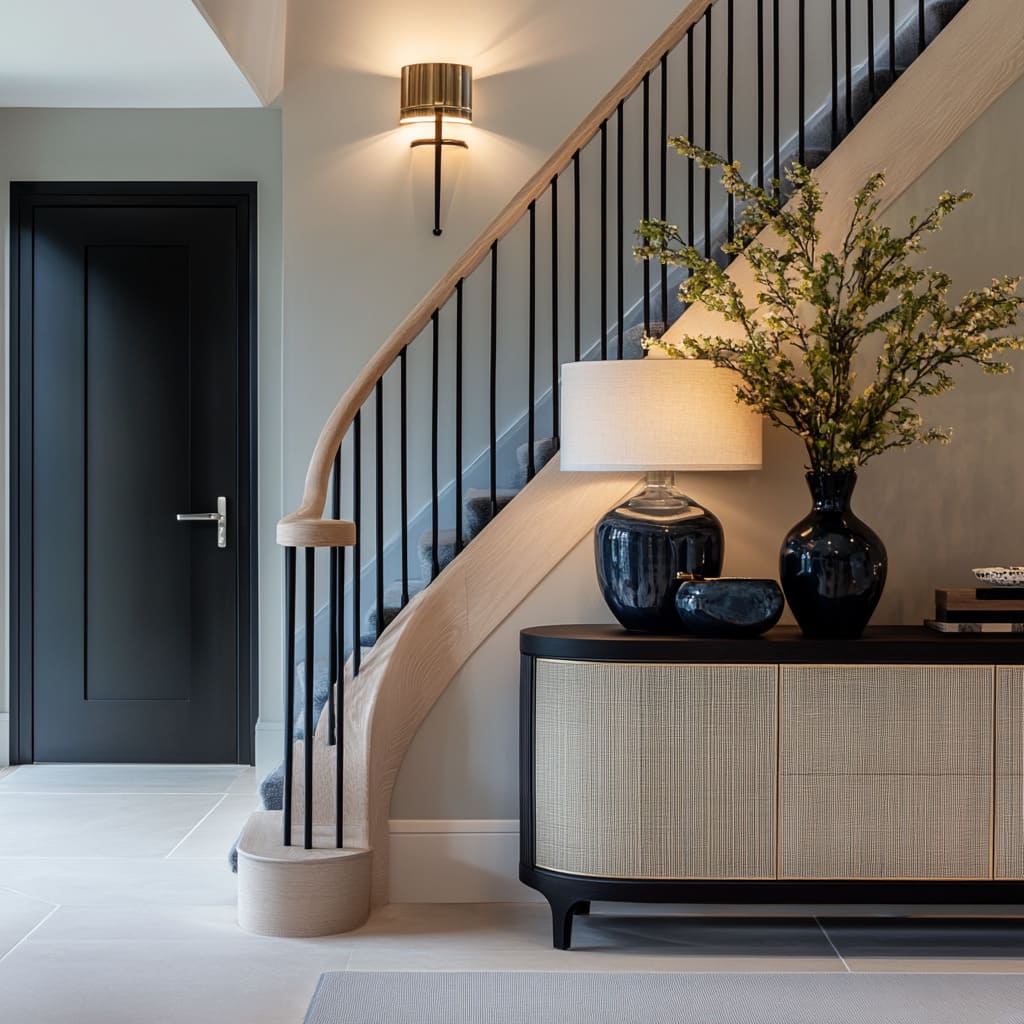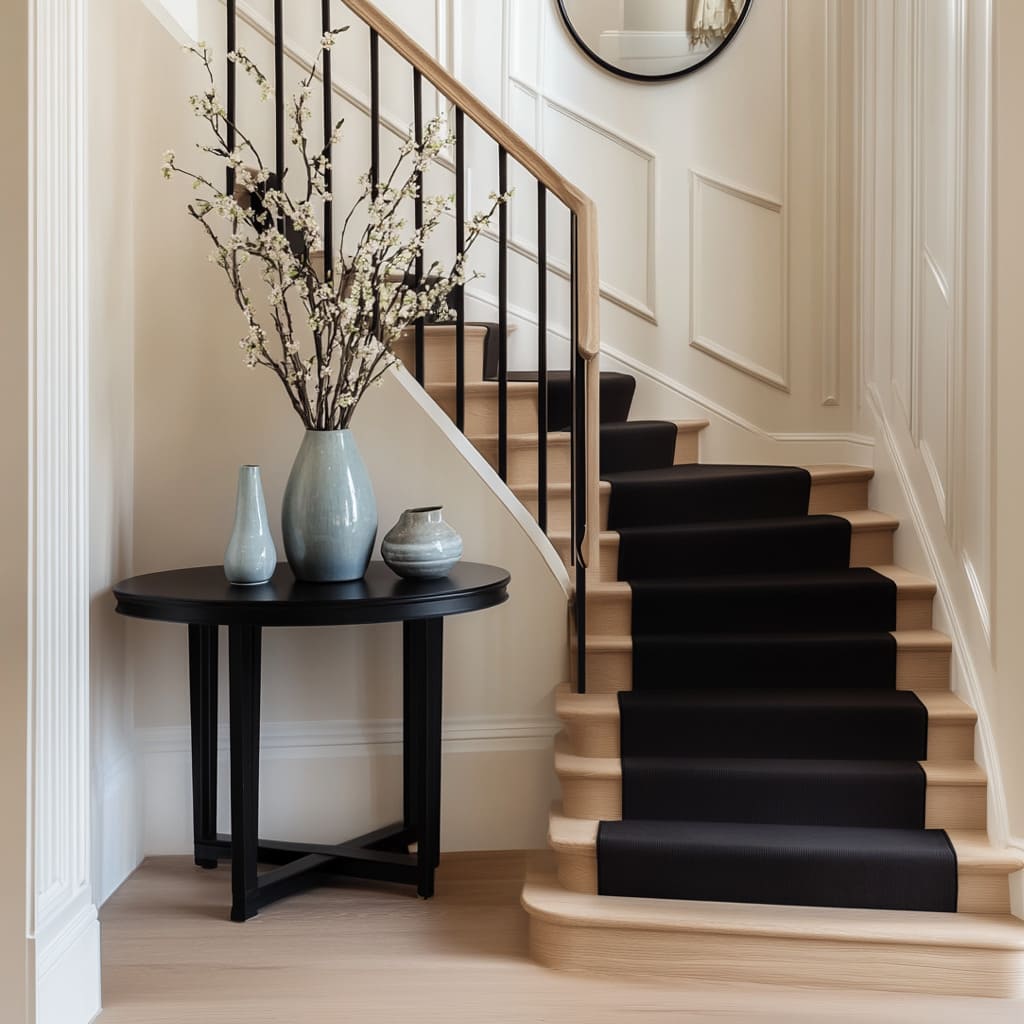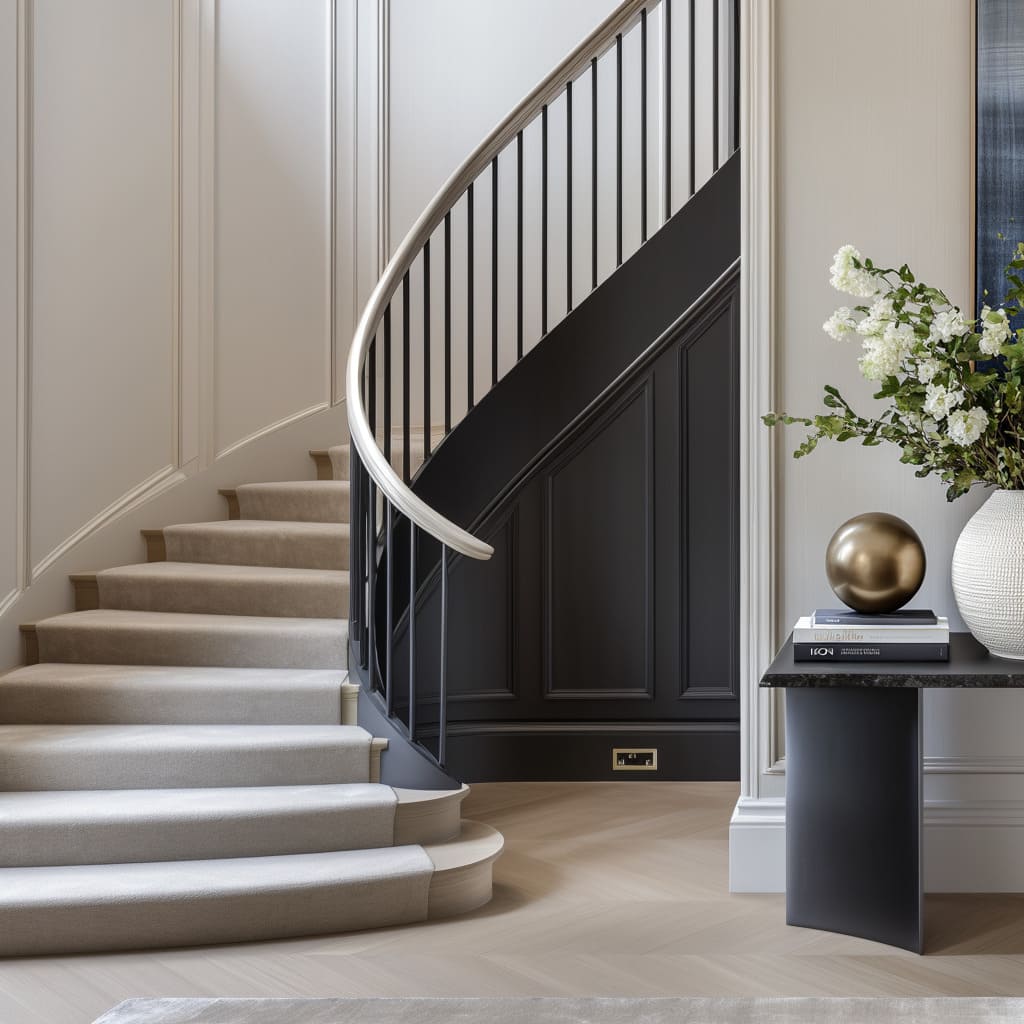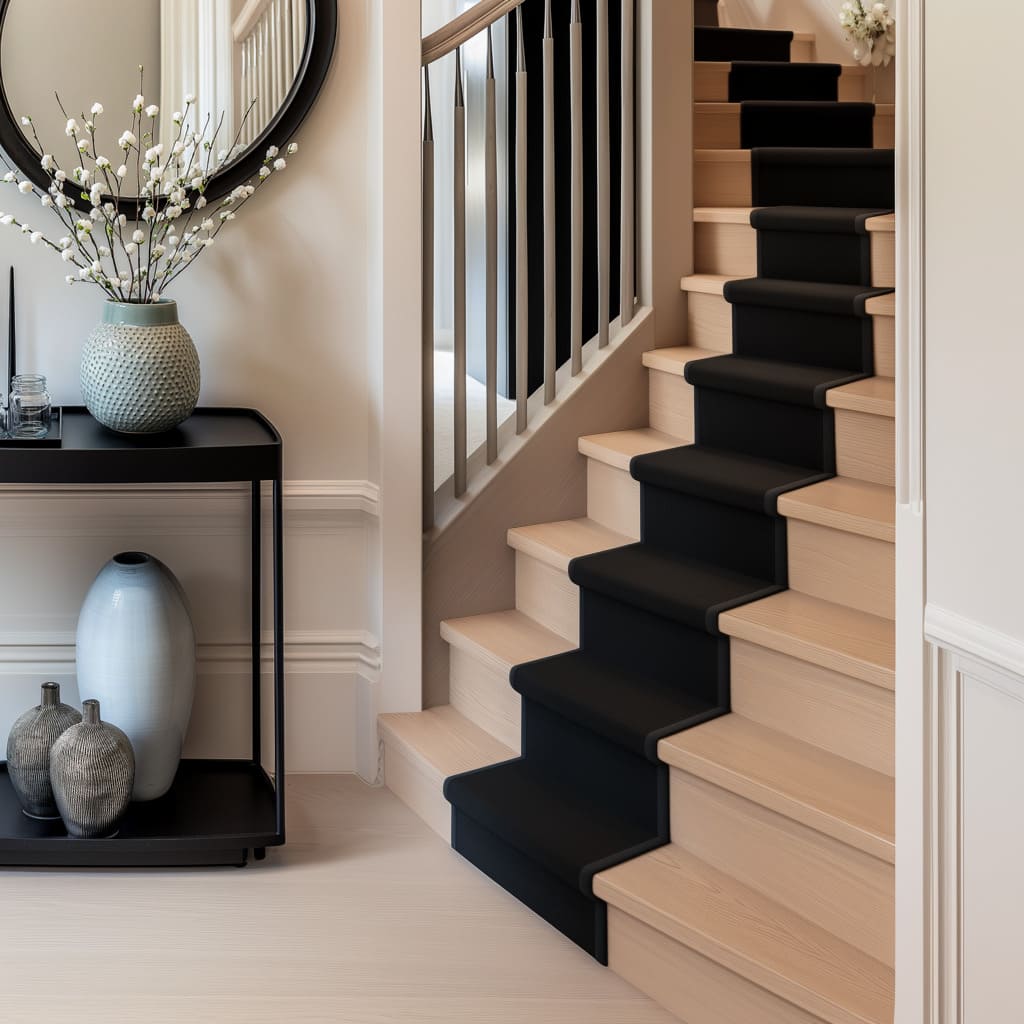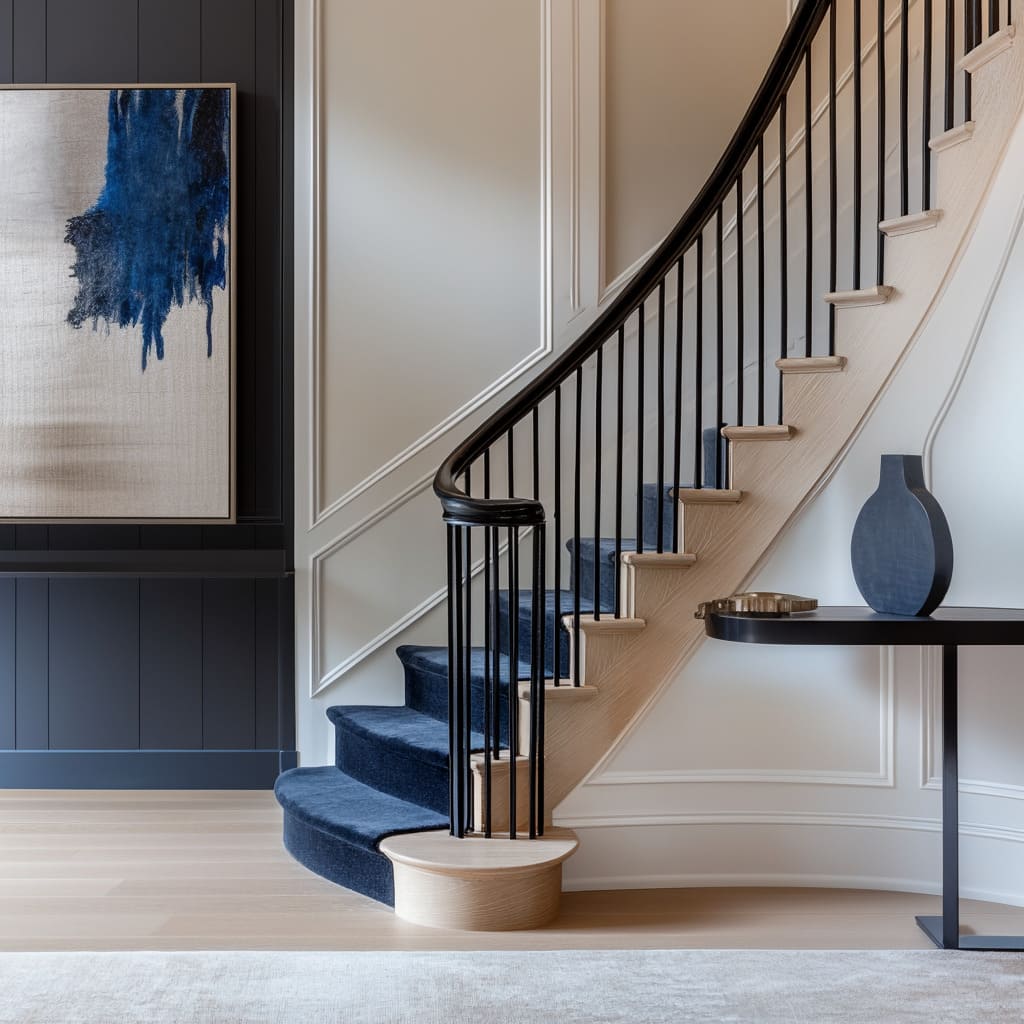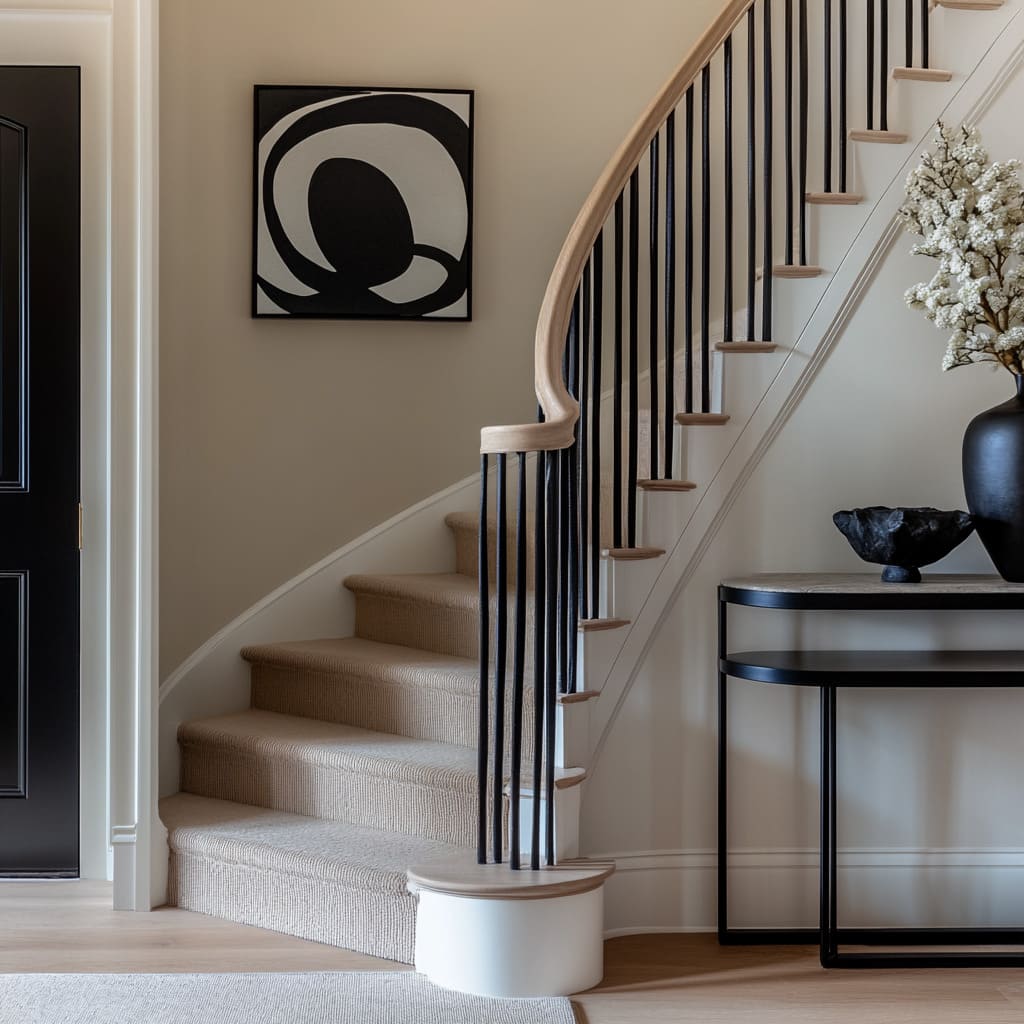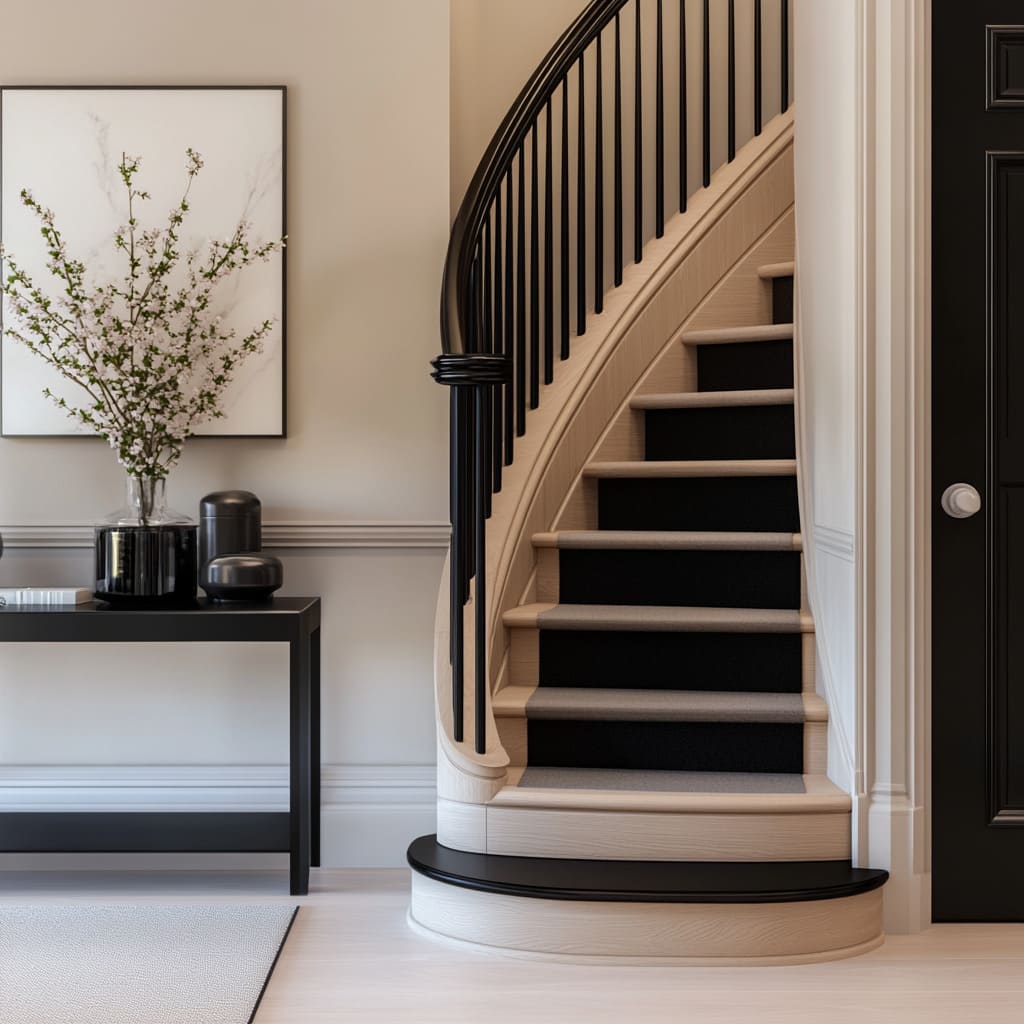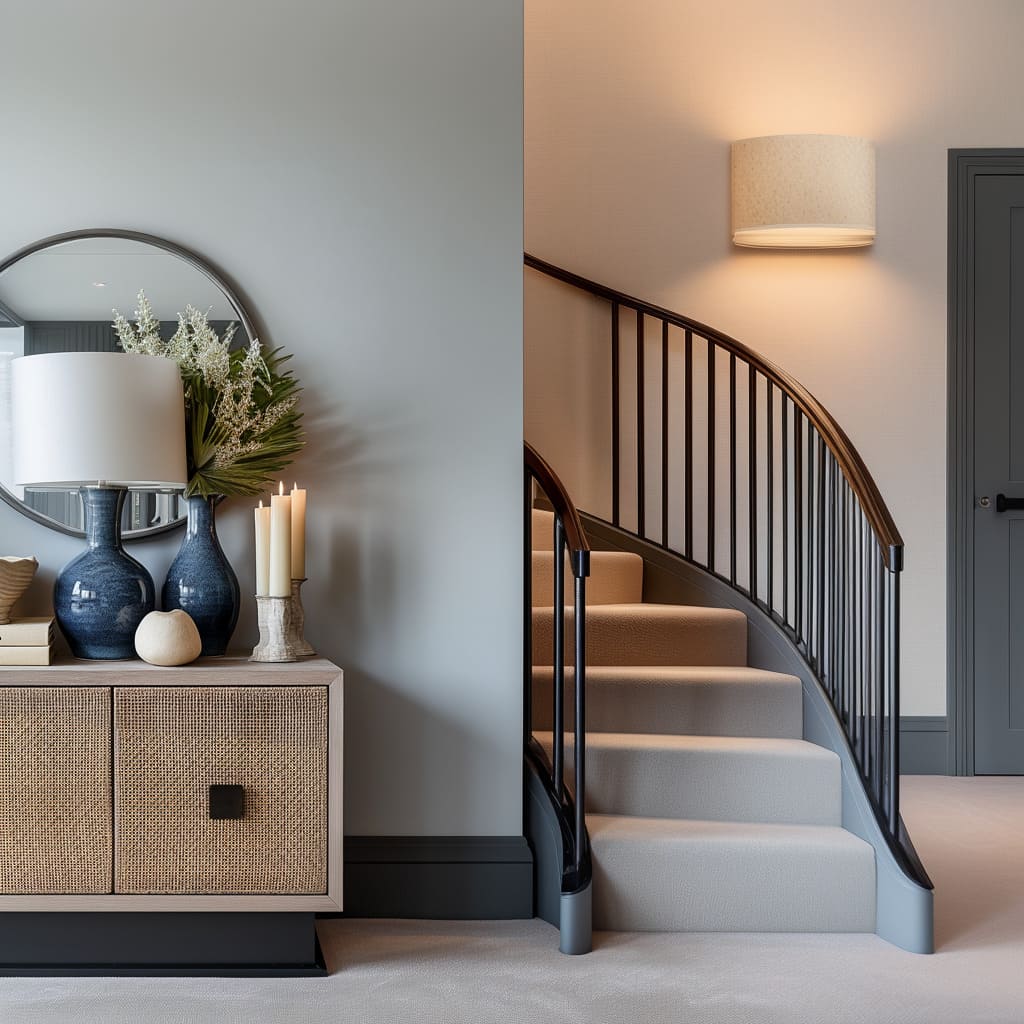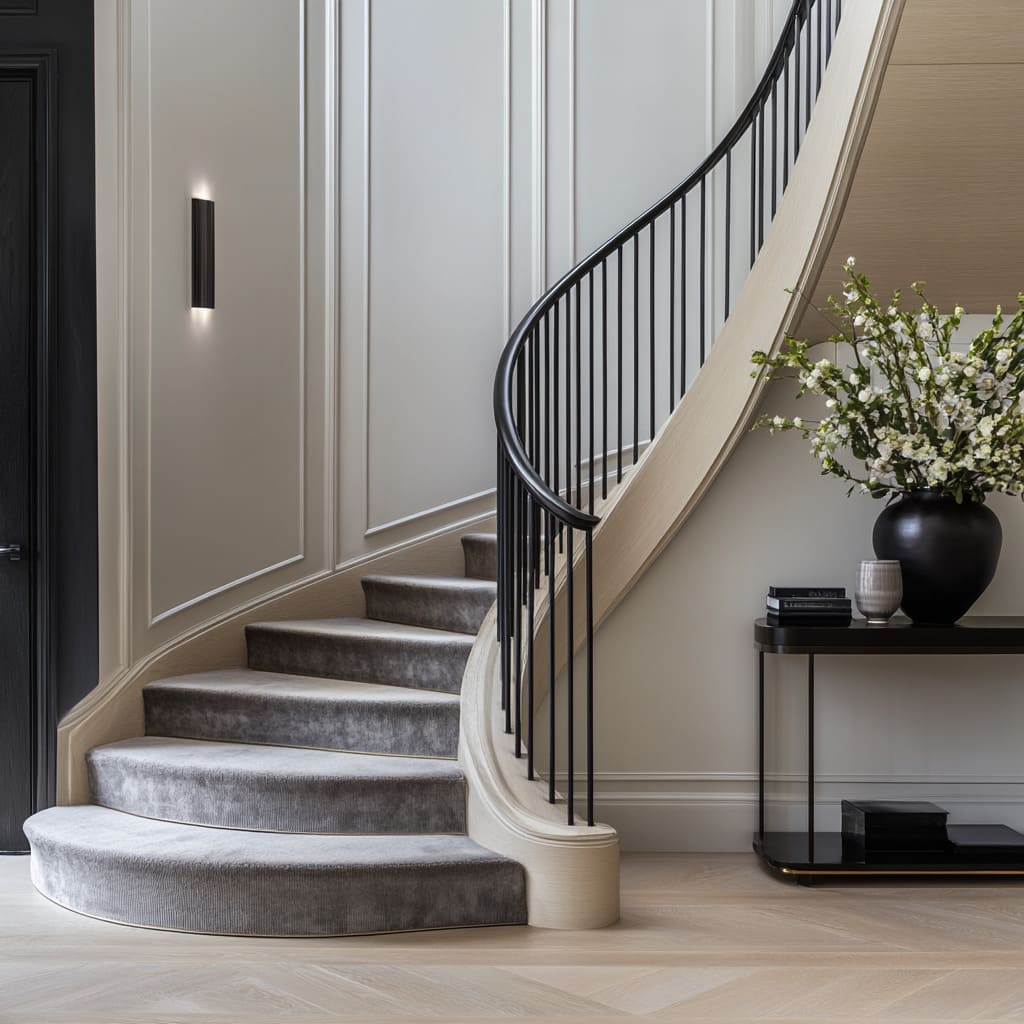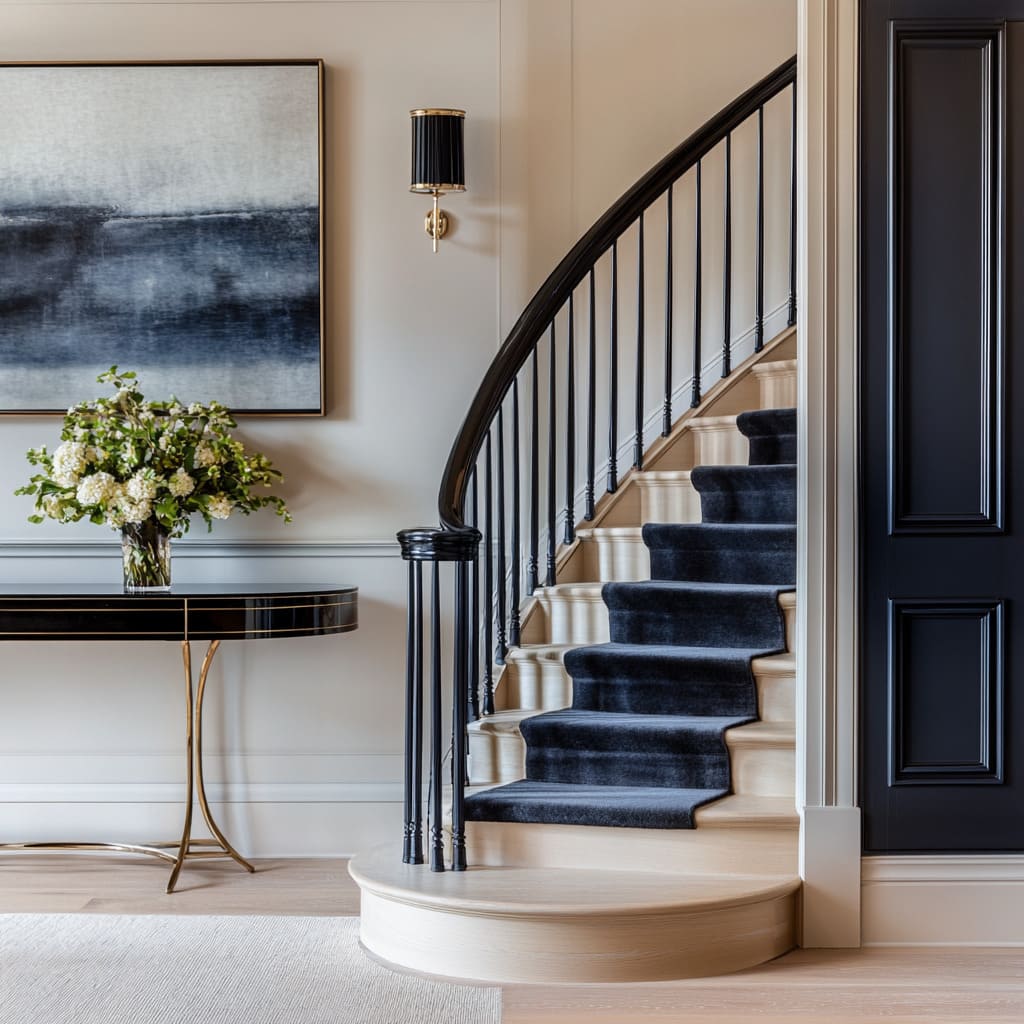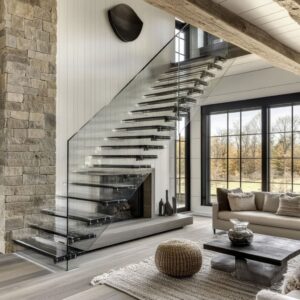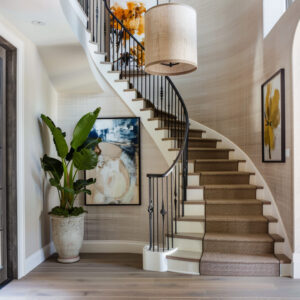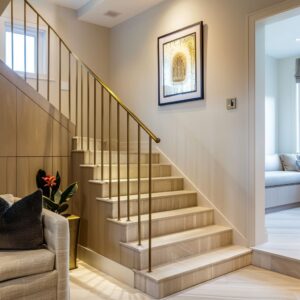In this article, we delve into the art of creating a beautifully designed carpet staircase, sharing practical principles, insights, and creative approaches. These ideas are meant to help you craft a design that is both visually striking and seamlessly tied to the surrounding interior.
By focusing on thoughtful combinations and attention to detail, you can create a staircase that serves as both a functional element and a design statement.
Integration of Materials and Textures
Wood and Carpet Harmony
One of the most timeless carpet staircase ideas involves pairing natural wood with carefully chosen carpet runners. The contrast between the solid, polished surface of wood and the soft, inviting feel of carpet creates a dynamic interplay.
Light wood, often chosen for its airy and versatile tone, works beautifully with neutral or darker carpets to create balance. Conversely, deeper wood tones are softened with lighter carpets, adding a sense of warmth and sophistication.
Contrasting Accents
Black iron railings or spindles, frequently seen in contemporary and transitional designs, are a striking addition to this combination. These dark accents draw attention to the staircase’s lines, adding definition to the wood and fabric elements.
This mix of materials also introduces a modern edge, perfect for spaces aiming to combine traditional craftsmanship with updated design aesthetics.
Insight
To highlight craftsmanship, focus on the natural grain of the wood. Combine it with textured carpet runners for stairs ideas that emphasize comfort, style, and practicality.
Opt for plush or ribbed textures to create visual interest while ensuring functionality, such as improved grip and reduced noise. This thoughtful mix of form and function ensures the staircase becomes an integral part of the room’s personality.
Color Combinations and Their Effects
Neutral Dominance: Neutral tones, such as beige, cream, and grey, are at the core of many timeless carpet designs for stairs. These understated shades act as a backdrop that allows the intricate architectural details of the staircase, like the railings and base steps, to stand out.
Neutral carpets are particularly effective in interiors where the goal is to maintain a cohesive and understated look, ensuring the staircase blends harmoniously with the overall aesthetic of the room.
Contrasting Dark Tones
For those looking to make a statement, deep navy or black carpet runners are an excellent choice. These darker tones provide a striking contrast against lighter wood steps and walls, creating a focal point that exudes sophistication.
Dark carpets also serve as a grounding element, anchoring the staircase visually within the space. This approach works beautifully in interiors with minimal color variation, as the bold runner adds depth and character.
Accent Matching
Matching the carpet runner’s color to nearby decor elements—such as upholstered furniture, wall art, or even curtains—enhances the sense of continuity in a room. This strategy ensures that the staircase isn’t viewed as an isolated feature but rather as an integrated part of the design.
A living space with neutral tones might benefit from a carpet that subtly reflects the hues of decorative items, creating an understated but cohesive color palette.
Insight
For minimalistic interiors, bold carpet colors can act as striking visual anchors, drawing the eye without overwhelming the space. Neutral tones, however, work best in transitional or traditional settings, blending effortlessly with varied decor styles.
Experimenting with patterned runners—such as geometric designs or soft organic prints—can introduce a unique dynamic, adding a layer of subtle texture and movement.
Architectural Emphasis
Highlighting Curves
A curved staircase is a design feature that deserves attention, and carpet runners play a pivotal role in enhancing its fluidity. By following the natural contour of the staircase, the carpet emphasizes its graceful curves.
Rounded base steps can serve as a design highlight, especially when paired with continuous carpet coverage and a railing that complements the overall flow. This approach brings attention to the staircase as an architectural centerpiece.
Stair Width and Scale
The scale of the staircase greatly influences the choice of carpet runners. Wider staircases benefit from the use of thick, luxurious runners, which add a sense of grandeur and elevate the design.
Narrower staircases, on the other hand, achieve a clean and refined look with slimmer runners that allow the natural beauty of the wood edges to remain visible. The balance between carpet coverage and exposed wood is essential for creating depth and texture.
Layering Paneling and Railing
Staircases with wall paneling add an extra layer of depth by combining multiple textures. The softness of the carpet contrasts beautifully with the clean, vertical lines of metal railings and the structured paneling on adjacent walls.
This layered approach works well in transitional designs, where traditional and modern elements intersect, offering visual interest without overwhelming the space.
Insight
To create a bold but cohesive design, consider pairing carpet runners with subtle patterns or textures to enhance the architectural details of the staircase. For example, combining a herringbone wood floor near the stairs with a patterned carpet runner can create a seamless connection between the staircase and the room.
Wall paneling, especially in soft tones, acts as a complementary backdrop that enhances the visual impact of both the carpet and the staircase itself. For homeowners exploring stairs with carpet ideas, these principles offer countless possibilities to transform a staircase into a standout design feature that enhances the surrounding interior while maintaining practicality and elegance.
Interplay Between Functionality and Aesthetics
Safety and Practicality
Carpet runners aren’t just about visual appeal; they bring real functionality to staircases. They provide traction, reducing the risk of slips—making them a practical choice for families with young children or homes with pets.
Textured or ribbed carpets are particularly effective in enhancing grip while adding subtle patterns to the design. Additionally, carpet runners help minimize noise, an important factor for multi-level homes where sound can easily travel between floors.
Visual Comfort
Beyond their functional benefits, carpets offer a sense of warmth and visual comfort. Plush options, with their soft textures, are especially inviting, creating a cozy atmosphere that suits both formal and casual interiors.
In colder regions, this added softness can make the staircase feel more welcoming, while in formal settings, a refined texture can add sophistication without being overly ornate.
Insight
For high-traffic areas, durability is key. Wool-blend carpets are an excellent choice as they resist wear and tear while maintaining a luxurious appearance.
By selecting materials that balance functionality with style, you can achieve a staircase design that is both practical and visually appealing, providing long-lasting comfort and safety. This principle can inspire homeowners looking for hall stairs carpet ideas that are both versatile and stylish.
Integration with Room Interior
Furniture Coordination
The area surrounding the staircase often plays a vital role in the overall design. Complementary furniture pieces—like console tables or sideboards—help tie the staircase into the larger room.
Black metal furniture can echo the tones of railings, while natural wood furniture reflects the warmth of stair treads. By mirroring these materials, the staircase feels like a natural extension of the space rather than a separate element.
Wall Finishes and Artworks
Soft paneling on walls adds sophistication and continuity, offering the perfect backdrop for the staircase. Bold artwork positioned nearby can amplify the design, whether through abstract pieces that reflect the color palette of the carpet or dynamic pieces that introduce a playful contrast.
This strategy enhances the staircase’s connection to the room while giving the area a focal point.
Lighting Elements
Thoughtful lighting is key to highlighting both the carpet and the craftsmanship of the staircase. Wall sconces placed along the staircase can illuminate textures and colors, while warm ambient lighting softens darker tones in the carpet or railing.
For those exploring modern staircase carpet ideas, lighting provides an opportunity to add a contemporary edge, such as through sculptural fixtures that serve both practical and aesthetic purposes.
Insight
The staircase’s impact on a room is significantly enhanced by carefully selected decor and lighting. By experimenting with bespoke fixtures, such as adjustable sconces or statement pendants, you can spotlight the textures and lines of the staircase while ensuring the space feels cohesive.
This approach allows the staircase to act as a design bridge, seamlessly blending functional utility with visual appeal.
Decorative Combinations
Organic and Geometric Fusion
One of the simplest ways to soften a structured staircase is by integrating natural and geometric elements. For instance, a floral arrangement in a ceramic or glass vase placed near the base of the stairs introduces organic shapes that contrast with the rigid lines of the staircase.
This combination strikes a balance between nature and modern design, making the staircase feel more inviting.
Black and Metallics
Black accents, whether in the form of railings or furniture, paired with metallic details such as brass sconces or gold-framed side tables, create a luxurious touch. The boldness of black grounds the space, while metallic highlights add warmth and subtle glamour.
This pairing works particularly well with light-colored carpet runners, where the contrast emphasizes the overall design.
Layered Minimalism
Minimalist interiors often benefit from fewer, but more impactful, decorative choices. A monochromatic vase or bold abstract artwork can elevate the staircase area, drawing attention without overpowering the space.
This is particularly effective when paired with understated carpet textures, allowing the art and décor to shine.
Insight
To redefine the staircase as a focal point, consider unconventional decorative stair carpet choices. Sculptural decor, oversized planters, or a mix of ornate furniture with simple carpet patterns can add an unexpected yet cohesive touch.
For transitional interiors, this blend of styles creates a dynamic and inviting atmosphere.
Design Dynamics of the Carpet Runner
Full Coverage vs Narrow Runners
Full-coverage carpets deliver a seamless and cohesive aesthetic, especially suited for traditional interiors. They envelop the staircase in a single tone or pattern, creating unity.
In contrast, narrow runners leave the edges of wooden steps exposed, framing the runner with natural wood tones. This approach works beautifully in spaces that aim for a mix of modern and classic design.
Edge Binding and Details
Adding bound edges to a carpet runner, especially in contrasting colors, elevates the design. For example, a grey runner with white binding introduces a subtle border that feels polished and intentional.
This detail can transform even simple carpet styles into statement pieces.
Runner Patterns
Patterns bring movement and rhythm to a staircase. Subtle stripes or herringbone designs add depth without overwhelming the overall look.
Bolder prints, like florals or geometric shapes, work best in spaces where the staircase serves as the focal point. Referencing pictures of carpeted staircases can provide additional inspiration for how patterns interact with different architectural styles.
Insight
Dynamic and engaging staircase designs often include dual-tone runners or contrasting borders that frame the steps. These details allow for creative exploration of textures and patterns, ensuring the staircase feels both cohesive with the room and uniquely stylish.
For homeowners seeking personalized touches, experimenting with intricate patterns or custom color combinations can result in a truly standout design.
Harmony Through Proportions
Balancing Scale
Achieving harmony between the staircase and the surrounding decor is all about maintaining proportion. For wider staircases, large decorative pieces, such as oversized vases or console tables, help anchor the space and create visual balance.
Narrower staircases benefit from slim or minimal furniture and decor that doesn’t overwhelm the area, maintaining an open and cohesive look. The relationship between the staircase and its immediate surroundings ensures a seamless flow throughout the room.
Heightened Perspectives
Tall staircases call for decor elements that draw attention upward, emphasizing the height and grandeur of the space. Wall sconces, vertical paneling, or even tall art pieces can accentuate the staircase’s verticality, making it a standout feature.
These touches help frame the staircase within its architectural setting, creating a polished yet inviting atmosphere.
Insight
Incorporating proportional decor ensures that the staircase integrates seamlessly with the larger room design. For smaller spaces, mirrors can visually expand the area, while glass railings add an airy and contemporary touch.
These simple adjustments can turn a staircase into a design feature that complements the room without overpowering it. For inspiration, exploring pictures of stairs with runners can reveal how proportions and decor combine to enhance staircase designs.
Seasonal or Functional Adaptability
Seasonal Updates
Carpet runners offer incredible versatility, allowing you to adapt your staircase to the changing seasons. In summer, lighter textures and colors create a breezy, refreshing look, while in colder months, denser and warmer materials like wool bring coziness and depth to the design.
This adaptability ensures the staircase remains an inviting feature year-round.
Functional Layers
Protecting carpet runners in high-traffic areas doesn’t have to compromise style. Removable protective layers, like thin overlays or transparent mats, can extend the lifespan of the runner without detracting from its appearance.
These functional additions are especially useful for families or spaces with frequent foot traffic.
Insight
Designing for adaptability means using materials and styles that can evolve with the seasons or needs of the household. Interchangeable runners or layered textures offer a flexible solution, combining practicality with aesthetic appeal.
For creative staircase rug ideas, consider experimenting with dual-layered runners or rotating seasonal designs that bring a fresh feel to your staircase throughout the year.
Conclusion: Building a Beautiful Carpet Staircase
Designing a visually captivating and functional carpet staircase requires attention to detail and a thoughtful approach to every element. By blending design principles with creative ideas, you can transform a staircase from a purely functional structure into a standout feature of your home.
- Blend Contrasts: Start by balancing bold accents, such as dark railings, with the softness of light-toned carpets and natural woods. This interplay of textures and tones creates visual depth while maintaining a cohesive design that feels both sophisticated and welcoming.
- Use Functional Beauty: Carpets with textured surfaces or subtle patterns not only enhance the staircase’s aesthetic but also address practical needs like reducing noise and improving safety. Functional design elements ensure the staircase remains beautiful and purposeful in everyday use.
- Integrate Surroundings: The staircase should feel like a natural extension of the room. Use decor, lighting, and furniture to tie the space together. For example, coordinating the color of the staircase runner with nearby decorative elements can create a seamless connection between the staircase and its surroundings.
- Highlight Architectural Details: Curved staircases, unique base steps, or intricate paneling deserve special attention. Carpet runners can be strategically chosen to emphasize these architectural features, adding a layer of refinement and depth to the overall design.
- Explore Not-Trivial Ideas: Creativity can elevate a staircase design. Try experimenting with bold border designs, metallic finishes in decor, or layered lighting fixtures that draw attention to the staircase’s unique elements. These unexpected touches can add personality and character to the space.
For homeowners seeking inspiration, exploring staircase runner ideas can spark innovative ways to reimagine this essential architectural feature. By following these principles and embracing creative opportunities, your staircase can become a true centerpiece, blending practicality with artistry in your home.

